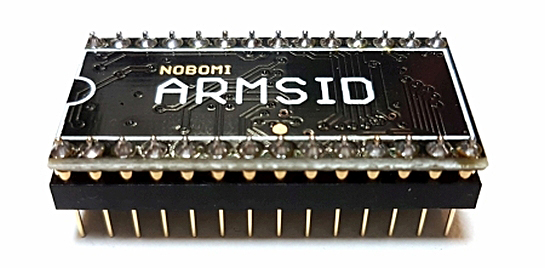
A new firmware update for the ARMSiD has been released by Nobomi.
News features and fixes in FW 2.16:
- Fix for 2 MHz mode C128. Since this firmware ARMSID is functional for all modes and types of communication with C128 (even those incompatible with SID documentation).
- Added to the configuration the possibility to use the EXT IN input (pin 26) as an analog input and connect it to the internal mixer, as on the original chip. You should expect a slight increase in noise background from this input, I recommend using it only when you really need this feature.
- Also added to the configuration the possibility to change the emulation detection threshold of the 6581/8580 according to the input voltage (pin 28), so called autodetection. Originally this limit is set to 10.5V, what is below indicates 8580 emulation, what is above so 6581. With the new setting, this limit can be about 2V, so you can use logic levels of 5V or even just 3V for switching the emulation type (pin 28 is not used for power supply in ARMSID, only for voltage measurement, no power supply on this pin is required for function).
Download: ARMSiD v2.16 [PRG/D64/CONFIG] (390)
source: nobomi.cz github.com/nobomi/Arduino-ARMSID-configurator
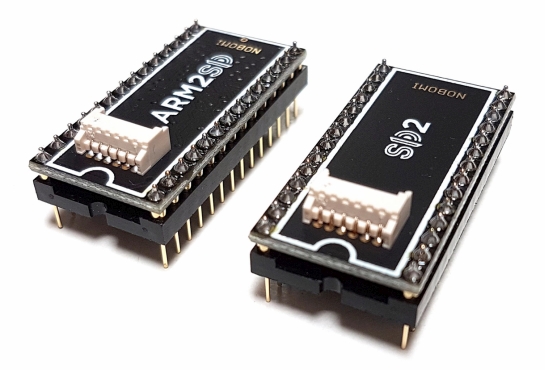
A new firmware update for the ARM2SiD has been released by Nobomi.
ARM2SID firmware 3.15:
- Please don’t forget to download also a new configuration program.
- Fixed a bug with noise generation in the highest octave (reported for example in Crossroads II and Jumpman).
- SID type detection with this algorithm returns the actual type setting from the ARMSID configuration.
- Among other tracks, this allows you to play the last part of Wonderland XIII, at least if the ARMSID is set to emulate MOS6581. Prodigy rulez !
- Fixed bad music timing in Turrican 2 – The Final Fight (audible in track 2).
- Added undocumented playback of the “no” waveform, making, for example, the Boing Boom Tschak whistle significantly less (about 20dB down).
- Modifications in the generation of combined waveforms (not only) for MOS8580 emulation, where they are more close to the original (as close as possible for chips that are themselves different from each other, also dependent on temperature, voltage and time).
Download: ARM2SiD v3.15 [PRG/D64/CONFIG] (359)
source: nobomi.cz

A new firmware update for the ARMSiD has been released by Nobomi.
News features and fixes in FW 2.15:
- Fixed a bug with noise generation in the highest octave (reported for example in Crossroads II and Jumpman).
- SID type detection with this algorithm returns the actual type setting from the ARMSID configuration.
- Among other tracks, this allows you to play the last part of Wonderland XIII, at least if the ARMSID is set to emulate MOS6581. Prodigy rulez !
- Fixed bad music timing in Turrican 2 – The Final Fight (audible in track 2).
- Added undocumented playback of the “no” waveform, making, for example, the Boing Boom Tschak whistle significantly less (about 20dB down).
- Modifications in the generation of combined waveforms (not only) for MOS8580 emulation, where they are more close to the original (as close as possible for chips that are themselves different from each other, also dependent on temperature, voltage and time).
Download: ARMSiD v2.15 [PRG/D64/CONFIG] (397)
source: nobomi.cz

A new firmware update for the ARM2SiD/ARMSID has been released by Nobomi.
ARM2SID firmware 3.14:
- Please don’t forget to download also a new configuration program.
- Fixed a bug in tone pitch when generating noise (reported for example in Crazy Comets and Paperboy in FW 3.11 and 3.12).
- Fix in SFX emulation (some tracks were missing percussion).
- Unified SFX emulation sample rate for all settings (with correct FM frequency reference set) to approx. 49.7kHz as on original card.
- Optimization for speed, not only for running the emulation itself, but also the bus response.
- Application start-up is also faster, instead of hundreds of milliseconds, the ARM2SID is fully functional in less than 15 milliseconds from power connection !
- CS signals from both sockets are handled as independent accesses (important for use in synthesizers).
- Added the possibility to “fix” the so-called ADSR bug, i.e. a bug in the envelope generator, which is inherent to the original chips and is reproduced in ARMSID too. This is not needed in the C64 for compatibility reasons, but if you use ARMSID in synthesizers, you might be interested in this feature.
- It is possible via configuration to disable the automatic extension of the left channel sound to the right channel if it is not playing for a long time (again, important for use in synthesizers).
- There is also an option via configuration to have only the data from the left channel play fixed to both SID channels (the emulation settings for each channel remain).
- Slightly modified quality (Q) of filter circuits for even more faithful reproduction of MOS8580.
ARMSID firmware 2.14:
- Please don’t forget to download also a new configuration program.
- Bug fix – lower noise waveform tone pitch (reported e.g. in games Crazy Comets and Paperboy when using FW 2.11 to 2.13).
Download:
source: nobomi.cz/8bit/arm2sid nobomi.cz/8bit/armsid

A new firmware update for the ARMSiD has been released by Nobomi.
News features and fixes in FW 2.13:
- Further optimization of code speed and size. Also bus operations are faster, finally “paddles” are successfully read on NTSC machines even with the oldest HW versions of ARMSID (with components on top) !
- ARMSID start is also faster. Instead of hundreds of milliseconds, ARMSID is fully functional in less than 15 milliseconds after power-up !
- Added the possibility to “fix” the so-called ADSR bug, i.e. a bug in the envelope generator, which is inherent to the original chips and is reproduced in ARMSID too. This is not needed in the C64 for compatibility reasons, but if you use ARMSID in synthesizers, you might be interested in this feature.
- Slightly modified quality (Q) of filter circuits for even more faithful reproduction of MOS8580.
Download: ARMSiD v2.13 (575)
source: nobomi.cz

A new firmware update for the ARM2SiD/ARMSID has been released by Nobomi.
ARM2SID firmware 3.12:
- Digifix in MOS8580 emulation is now configurable. By the software it can be set to a several levels including inverse polarities.
- The Digifix is controlled by external pin current by default (as a real MOS6581 is). If you miss it, just set it by the configuration program as you want.
- Digifix for MOS8580 is required for example in the Ghostbusters game, but most of the games, demos and music (specially new ones) is not counting with Digifix and can produce some additional noises and hum.
- In this FW is finished the hotfix in noise generation (test bit) from previous FW, now is no sound missing for example in the TestBit_4x.sid.
- Big improvement in 6581 emulation. Fixed inner analog offsets in the MOS6581 emulation. Less distortion in some demos (for example Mahoney – Musik Run/Stop) and no more clicks in some games music (for example Bubble Bobble).
- Fix in tone counter updates during fast changes.
- Fixed setting of the lowest filter frequency for MOS6581 emulation (sometimes the simulation did not match the settings).
ARMSID firmware 2.12:
- Fixed setting of the lowest filter frequency for MOS6581 emulation (sometimes the simulation did not match the settings).
- Remember the “Digifix” update from the previous version, if something sounds different to you on the MOS8580 emulation, please check the configuration.
Previous changelog of ARMSID firmware 2.11:
- Digifix in MOS8580 emulation is now configurable. It can be set to few levels including inverse polarities.
- Digifix is now controlled by external pin by default (as a real SID is). You can change it in config utility.
- Digifix for MOS8580 is required for example in the Ghostbusters game, but most of the games, demos and music (especially new ones) do not expect Digifix and can produce some additional noise and hum.
- Improved noise generation (test bit) from previous FW, no sound missing for example in the TestBit_4x.sid.
- Fixed inner analog offsets in the MOS6581 emulation. Less distortion and no more clicks in some music.
- A small fix in tone counters updates in the fast changes.
- Faster release of the data bus after reading cycle.
Download:
source: nobomi.cz/8bit/arm2sid nobomi.cz/8bit/armsid

A new firmware update for the ARM2SiD/ARMSID has been released by Nobomi.
News features and fixes in FW 3.8 & v2.10:
- Fixed a bug from older versions in the values generation of the register OSC3 during a noise waveform. Reported in the game Paradroid.
Download:
source: dzi.n.cz/8bit/arm2sid dzi.n.cz/8bit/armsid

A new firmware update for the ARM2SiD has been released by Nobomi.
News features and fixes in FW 3.7:
- Compared to version 3.6, only marginal changes, added reading of OSC3 and ENV3 registers to the third SID emulation.
- Simplified user interface for the update application.
- Compared to version 3.5, a quick response in stereo mode was added (when using a second socket), the dual-mono mode is activated without timeout when both socket is addressed in the same time.
- Also upper addresses mapping is fixed in the update (sometimes misaligned address detection in the update application).
- Corrected bug in bootloader. If user tried an update with SFX only mode configured, the ARM2SID stuck in the bootloader and was not possible to update it on a user side. Factory update was needed. New updater disables the SFX mode, as well as patches the bootloader to prevent problems in a future.
Download:
source: dzi.n.cz/8bit/arm2sid
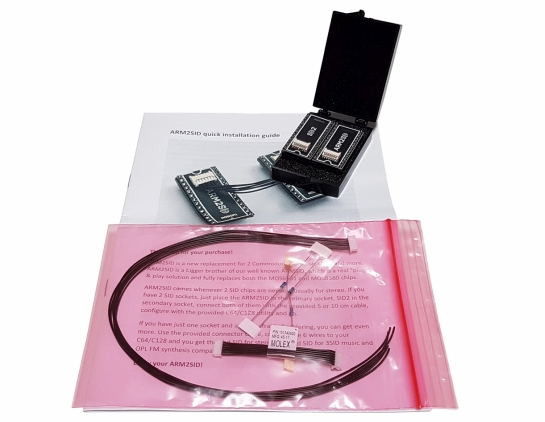
ARM2SID SIDs (until 3) & SFX Sound Expander (OPL FM synthesis) emulator.
Nobomi still amazes us with the ARM2SID a new TWO or THREE SIDs and SFX Sound Expander (OPL FM synthesis) “emulator”.
The socket size of the ARMSID is DIP28 and is absolutely the same of the original chip and therefore fits perfectly in all situations.
The audio quality is really good for both; SFX Sound Expander (OPL FM) and the SID emulation.
It also possible add a second socket as the second SID if you have Stereo/U64/Reloaded adapter or connect wires directly to your Commodore computer.
- A next logical step after succesful ARMSID. ARM2SID is based on the same blocks as ARMSID but one step more advanced blocks.
- Thanks to them, it added the possibility of emulating up to two additional chips and / or FM synthesis with OPL2.
- Like ARMSID, ARM2SID is a replacement for the MOS6581 and MOS8580 circuits used in Commodore C64/C128. It comes again in a minimalist form, but it can do a lot more.
- It can replace up to 3 chips at the same time, it can also emulate SFX sound expander as well as the newer FM-YAM clone.
- SIDs emulation itself is the same as with ARMSID, so emulation features can be read on its page.
- Up to 12 channels music (two or three SIDs or FM or one SID and FM)!
- Works with all C64 and C128 boards (please read manual)
- Stereo in any combination of SID 6581 or 8580 models.
- Automatic fall-back to dual mono if second SID is not used.
- Configuration and upgrades by software utility in C64/C128.
More information can be found on the Nobomi website or RETROCOMP.cz
Gallery:
Video:

A new firmware update for the ARM2SiD has been released by Nobomi.
News features and fixes in FW 3.6:
- Compared to version 3.5, a quick response in stereo mode was added (when using a second socket), the dual-mono mode is activated without timeout when both socket is addressed in the same time.
- Also upper addresses mapping is fixed in the update (sometimes misaligned address detection in the update application).
- The “blind” FW 3.6 update updated without reading the registers during the update (especially useful if you have a problem with ARMSID detection)
Download:
If you have wired A5/A8 address lines, you can try 3SID files modified for D400h, D420h, and D500h addresses.
source: dzi.n.cz/8bit/arm2sid

A new firmware update for the ARMSiD has been released by Nobomi.
News features and fixes in FW 2.9:
- A longer time is required to activate the reset signal (some issue with board 250407 reported where can be short spikes on the bus, now fixed).
- Small fix in noise generator on the lowest bits. Also faster computing.
- Other speed and code size optimization.
Download: ARMSiD v2.9 (963)
source: dzi.n.cz/8bit/armsid
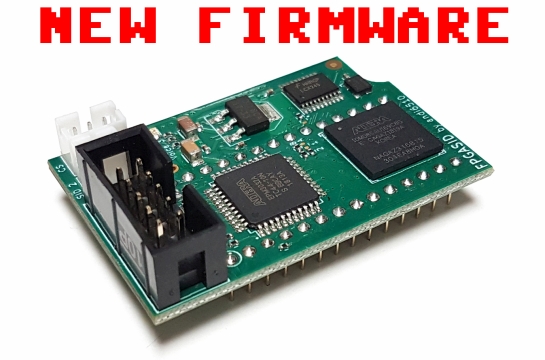
A new firmware update for the fpgaSID has been released by andi6510.
Below the changelog taken directly from the website.
Main changes:
- New 6581 bias setting range and curve. Per default the bias is now tuned to a brighter sound which is the most audible difference to revision 09.
- Some further improvements on the 6581 filters.
New Features:
- LEDs can be switched off now.
- The outputs can be switched to a mix of both SIDs allowing mono setups with a single speaker.
- The firmware flashing procedure has been improved to increase the success rate.
- FPGASID is now compatible to the EasyFlash 3 module.
Note:
- Important! Before updating the firmware, please read the documentation on flashing in the ConfiGuru manual.
Download: fpgaSID Firmware ver. 0A (906)
source: fpgasid.de

Nobomi has made a new revision of the ARMSiD PCB which however has the same hardware features as the previous one.
A new firmware update for the ARMSiD has also been released by Nobomi.
Below is the changelog taken directly from the website.
Differences between FW 2.8 and previous version:
- The start and the end of the bus data cycle (reading or writing) is now controlled by signal CS only (it was the same on the beginning of the cycle, but the end was controlled by 02 clock before), it can help with a bus stability in other systems than C64 a C128.
- Internal frequency generators are updated with precision of one 02 clock – about 1us (no audio signal phase changes after frequency retuning) !
- Correct polarity of the bandpass filter.
- Added emulation of internal filter voltage offset.
- Added the “Digi Boost” feature by software – an effect similar to adding 330kOhm resistor between EXTin and GND on the MOS8580.
- Other speed optimization.
Gallery:
Download: ARMSiD v2.8 (17/2/2019) (941)
source: dzi.n.cz/8bit/armsid
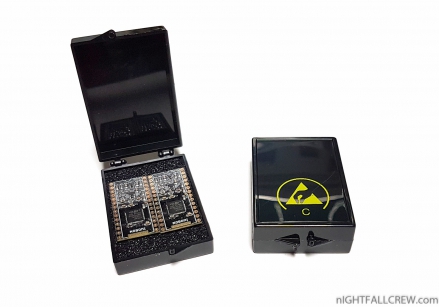
ARMSid (6581/8580 Replacement) by Nobomi.
I could not resist the temptation to try also this emulation of the SID 6581/8580 with the STM32F410 ARM Cortex M4, i’m talking about the ARMSid by Nobomi.
The fast shipping and the courtesy of Nobomi are certainly very well but also the packaging, the ARMSid is shipped in a plastic case to avoid any problem with the shipping.
The sound and the “audio” feeling are good like the SwinSID Ultimate but better, personally i would place the ARMDSid between the Original SID and the SwinSID Ultimate, Nobomi you have made a very good job. Congratulations.
Nobomi also wrote a software for Commodore 64 to configure the various ARMSid options and another software to update the Firmware.
Some information taken from the Nobomi site:
What is it ?:
- A new replacement of the MOS6581 and MOS8580 used in the Commodore C64. It is minimalistic (in simplicity of circuit and use, not in function and power).
- Real “plug & play” solution. Just insert instead of the original SID into the slot and it’s done.
- It determines (through supply voltages) which chip it replaces and starts the appropriate emulation (it can be changed later in software).
- No need to switch the PAL / NTSC version, the circuit uses directly the clock from the computer bus, always synchronous with the C64.
- It also emulates analog inputs (joysticks, mouse, etc. – POTX and POTY inputs)
- Analog output is sufficiently buffered, it is not necessary to change anything on the computer board for proper operation.
- Output sampling frequency is 1/16th bus clock of C64 (approx. 62kHz), real 12bit D/A converter, no pwm.
- Filters completely transferred to digital form, emulated by float point arithmetic.
- Significantly lower noise level and less interference from the power supply than the original :)
- Lower power consumption than the original.
- Firmware update possible inside the C64.
- Emulates all waveforms, and even “samples” (at least some of them, Ghostbusters laugh, Chimera screams at you).
- Full support of analog filters (LowPass, BandPass, HighPass, combination, Q quality control).
- Emulation of OSC3 and ENV3 registers (little delay, approximately 16 clocks of the C64 bus).
- Joysticks and mice work.
What is inside ?:
- A few resistors, capacitors, one stabilizer, one opamp and a processor. That’s all, parts only from one side.
- The only programmable circuit is the STM32F410, ARM Cortex M4 with HW float point arithmetic at 100MHz.
- Analogue output amplified via the AD8515 opamp.
- Stabilizer for the 3.3V processor, the processor itself has 5V tolerance inputs.
Firmware:
- New features in FW 2.6:
- Optimization for speed again (approx. 10ns more faster response to read registers, faster processing of writing registers).
- New features in FW 2.5:
- Again faster interrupt (approx. 10ns more faster response to read registers).
- New features in FW 2.4:
- Further optimization of the interrupt (approx. 20ns faster response to read registers).
- New features in FW 2.3:
- A part of source code (interrupt routine) has been rewritten in assembler and manually optimized.
- It makes a possibility to control the bus only through the CS signal (no need for O2 clock synchronization, so it can run on systems with a different CPU than MOS6502 now).
- Low frequency limit and filter strength settings and saving settings to permanent flash memory.
Gallery:
Download:
ARMSiD Video:
source: ARMSiD Homepage
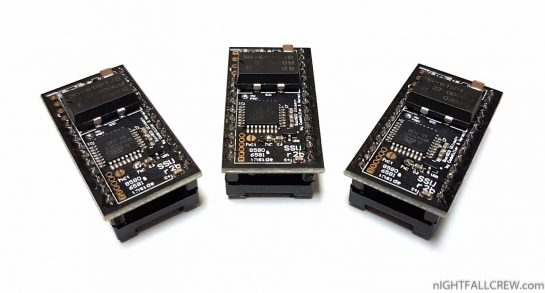
I tried the SwinSID Ultimate (SID 6581/8580 Replacement) by CodeKiller & Hermit and the base work by Swinkels with a Commodore 64 and the Ultimate-64 by Gideon and i must say that it works well without any problem.
The sound and the feel is good and knowing many SID tunes i did some comparisons, i can only say that these two Hungarian guys have done a Great job.
Forget immediatly how sounded the old Swinsid.
Some information taken from the SwinSID Ultimate site:
A duo from Hungary, Máté “CodeKiller” Sebők and Mihály “Hermit” Horváth have been working on improving SwinSID, originally developed by Swinkels.
List of improvements:
It has full feature compatibility with the original SID (over the old SwinSID):
- paddle/mouse support.
- readable registers (OSC3/ENV3)
- external audio in.
- bitfade.
- proper ADSR-bug support.
- fast ADSR attack rate (thanks to the self-correcting rate-counter)
- ‘Lazy Jones’ and ‘180’ -like gate and test-bit workaround (no missing note)
- proper 23bit noise-waveform calculation –> better “random” numbers.
- full 3V p-p output range w/o 1KOhm load (same as 8580)
- improved filter quality (16bit) and resonance-table for both SID model.
- improved waveform calculation (full 16 bit)
- high resolution combined waveform-tables.
It has enhancements over the original SID:
- clean anti-aliased bandlimited sound at high pitches.
- undistorted mixed digi tunes and eliminated volume-change click thanks to AC/DC separation of master volume register.
- Softconfig — software configurable options for a number of aspects of the operation.
- LEDs which intensity represents the active channels volume.
- LED displaying the active (classic) digi playback.
- or in case of the new Mahoney-digi, the entire array acts like a VU-meter.
Software configuration options:
- change between 8580/6581 behaviour (filter, ADSR, combined waveforms)
- change between PAL/NTSC pitch.
- enable/disable external audio input (less external noise)
- if enabled, then CAN be enabled to sample trough OSC3 register.
- enable/disable startup “ding”(beep)
- upload 3 banks of 256 bytes custom waveforms.
- “transparent” mute for channels — does not affect the sync, OSC3/ENV3,..
Gallery:
Download:
SwinSID Ultimate Video:






































Recent Comments